Implications
Knowledge on the economic impact of claw lesions and lameness helps to understand how both the diseases influence economic losses, and indicates how these problems should best be addressed. The fact that the prevalence of lameness varies throughout the reproductive cycle and peaks after sows were housed in the insemination stable is crucial for risk factor analysis. Furthermore, it implicates that focus on housing in the insemination stable is important to improve the prevention strategy.
Introduction
Lameness is a growing concern in swine breeding herds. Owing to the pain, suffering and limited freedom of movement, lameness is recognized as an important welfare concern (Whay et al., 2003). Nowadays, the disease condition is implemented in the Welfare QualityR Assessment Protocol for pigs (Welfare QualityR , 2009).
QualityR , 2009). In addition to the impaired welfare, lameness is allied to financial loss estimated at h37 per lame sow in Germany (Grandjot, 2007), $180 per lame sow in the United States (Deen et al., 2008) and in a Dutch study, h20 to 30 per sow present in the farm (Schuttert, 2008). Economic losses can be attributed to increased work load, higher veterinary costs because of treatment or euthanasia, higher risk for total or partial condemnation resulting in less slaughter revenue and to an impact on reproduction (Rowles, 2001; Schuttert, 2008). The impact on reproduction can be divided into a direct and an indirect effect. Literature on the indirect effect of lameness on reproduction is more widespread and much more consistent than the direct impact on reproduction.
Indirectly, lameness may affect reproduction of sows by influencing sows’ longevity, behaviour and feed intake. Lameness is the most important reason for euthanasia and the second most important reason for involuntary culling (Engblom et al., 2007; Jensen et al., 2010), leading to a detrimental impact on sow longevity. According to Bonde et al., (2004), lameness leads to uncontrolled lying-down behaviour and, as a consequence, it may augment the risk of crushing piglets. The higher level of acute-phase proteins in lame sows indicates the presence of inflammatory processes (Heinonen et al., 2006). Cytokines released by the inflammatory processes predispose to anorexia and lethargic behaviour (Johnson, 1997). In addition, Fitzgerald et al., (2012) reported a negative effect of overgrown toes on feed consumption during lactation. Early culling of sows, reduced feed intake and impaired locomotion indirectly decrease the mean number of litters per sow per year and the mean number of weaned pigs per sow per year, increasing the cost per weaned piglet.
However, the direct effect of lameness on reproduction (i.e. direct improvement or deterioration of the breeding or farrowing performance of a sow), is less clear. Several studies did not find any effect (Kroneman et al., 1993; Andersen and Bøe, 1999; Heinonen et al., 2006; Willgert, 2011), whereas other studies described a negative relationship between lameness and farrowing performance (Grandjot, 2007; Anil et al., 2009). Moreover, comparison between these studies is difficult as different methods and different stages in the reproductive cycle were used to assess lameness. As sows can recover over time, it may be recommended to assess lameness in the same sows at several times. In addition, knowledge on the stage in the reproductive cycle at which lameness is most prevalent may have a key value regarding risk factor analysis.
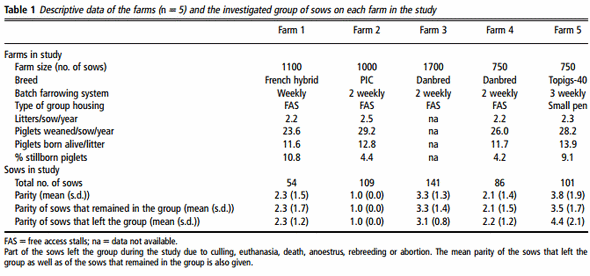
In breeding herds, sows are commonly housed in three main areas: the insemination stable (shortly after weaning), the gestation stable and the farrowing crates. Each of these areas is related to a different physiological status of the sow and is characterized by its own specific floor, feeding strategy, environment and management. Several studies already referred to floor characteristics (Newton et al., 1980; Mouttotou et al., 1999) and feed (Simmins and Brooks, 1988) as important risk factors for claw lesions and lameness. When sows are moved to a new area within the farm, the possible risk factors for development of lameness to which sows may be exposed will also change. The aim of the present study was to evaluate the shortterm effect of lameness and claw lesions on (re)production at the three main stages of the reproductive cycle in sows. In addition, the prevalence of lameness and claw lesions was investigated at each of these three stages.
Material and methods
Animals and housing
A total of 491 sows from five randomly selected farms were included in the study. General information about every farm is given in Table 1. All farms had at least 750 sows and all sows were housed in groups during gestation. On all farms, the gestation stable was provided with a partly slatted, concrete floor without bedding material. Farms 1 to 4 used free access stalls. On farm 5, sows were housed in small groups of 15 sows per pen and were fed by use of trough feeding. Space per animal during gestation ranged between 2.0 and 2.6 m2 . At the insemination unit, sows were housed individually with solid concrete flooring in the front half and concrete slats in the rear half. Only on the farm 5 metal slats were used in the rear half. The width of the concrete slats varied between 8 and 11 cm whereas the metal slats measured 1 cm. Slots of the floors on all farms did not exceed 2 cm. Farrowing stalls contained cast iron (partly), slatted flooring without bedding. During lactation, sows were provided feed and water ad libitum. As farm 2 had recently started with new sows, all sows had farrowed only once at the beginning of the study
Measurements
Within each farm, one randomly selected group of sows was followed up for a period of one reproductive cycle (from weaning to weaning). Every group was investigated five times, that is two claw lesion scorings and three lameness assessments, over a period of 5 months (Figure 1). Visual lameness assessment was performed on the day the sows were moved from one stage on the farm to another (L1, L2 and L3) and was based on the Welfare QualityR Protocol. In this protocol, a lame sow is defined as a sow unable to use one or more limbs in a normal manner varying in severity from reduced ability to bear weight, to total recumbancy. However, in the present study, only distinction was made between lame and healthy sows. Claw lesion scoring of sows was carried out twice in the farrowing stable: 1 week before the sows were weaned (C1) and 1 week after farrowing (C2) (Figure 1). Seven claw parameters were scored: length of toes, length of dew claws, wall cracks, heel cracks and/or overgrowth, skin lesions above the claw, heel–sole cracks and white line cracks. The first five parameters were based on the Dutch scoring method ‘Nederlandse Zeugenklauwencheck’ (Hoofs, 2006). The last two parameters were scored following the ZinproR Feet First method (Feet FirstR Team, 2010). Each of the four claws of the hind legs were scored from one to four, with score 1 meaning no lesion and score 4 meaning a severe lesion. The sum of the score of the four claws was made and was called the ‘total score’ (minimum 4 to maximum 16). However, when performing statistical analysis, total score was included as a dichotomous variable. This means that sows without lesions on any of the four claws (total score 5 4) were coded 0 and sows with a total score of 5 to 16 were coded 1. By summing the seven ‘total scores’, a ‘global score’ was obtained for each sow (minimum 28 to maximum 112). For the data and statistical analyses, global scores were regarded as continuous variables.
Parity of sows was categorized into four groups: 1, 2, 3 to 5 and >6 parity. Reproduction results in this study are defined as a combination of the farrowing performance, crushed piglets and the breeding performance. Information on farrowing performance and crushed piglets that was collected for the investigated cycle included the number of piglets born alive (continuous variable) and the absence or presence of stillborn piglets, mummified foetuses and crushed piglets (dichotomous variables). The breeding performance of sows included ‘showing oestrus post-weaning’, ‘weaning-to-oestrus interval’, ‘returning to service’ and ‘abortion’ (defined as expulsion of foetuses between day 35 and day 108 of gestation). The weaning-to-oestrus interval was regarded as a continuous variable, the other three as dichotomous variables. Coming into oestrus within 10 days after weaning, positive pregnancy diagnosis by ultrasound scanning 23 to 35 days after breeding and absence of abortion were coded as normal (0).
Sows that left the group during the study were recorded, as well as the time and the reason (not coming in oestrus, returning to service, abortion, death, euthanasia or culling).
Figure 1 Measurements during the reproductive cycle of the sows: Lameness assessment was performed when sows were moved between different stables (L1 to L3). Claw lesion scoring was performed in the farrowing stable: 1 week before weaning and 1 week after farrowing (C1 and C2). Reproduction data of one period were considered (breeding performance, farrowing performance and crushed piglets). C1, C2 5 claw lesion score; L1, L2, L3 5 lameness assessment 1, 2 and 3.
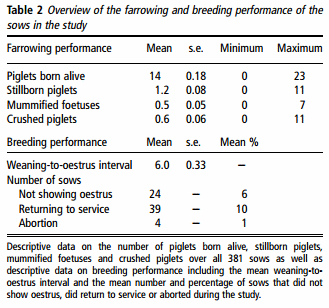
As it is essentially different, distinction was made between sows that left the group because they were removed from the farm (sows removed from the farm) and sows that left the group but that remained on the farm (sows removed from the group). The reasons for removing sows from the farm were culling, euthanasia or death. The reason why sows left the group but remained in the farm was because they did not show oestrus, they returned to service or they aborted. An overview of the reproduction results across all farms is given in Table 2.
Statistical analysis
Normality of continuous variables was evaluated. Linear and logistic regression models were built with farrowing and breeding-related variables as dependent variables. To account for the clustering of sow in the farm, a fixed farm effect was included. In addition, total and global claw lesion scores, as well as lameness and parity, were included as fixed effects. A stepwise forward model-building procedure was followed, and all factors with a P-value ,0.05 were retained in the final multivariable model.
Descriptive statistics were used to illustrate the prevalence of claw lesions and lameness throughout the productive cycle. To evaluate whether parity and global score differ between healthy and lame sows (0/1), between sows that were (1) or were not (0) removed from the farm, and between sows removed because of lameness (1) or because of other reasons (0), univariable linear regressions, with either parity or global score as dependent variable and farm as fixed effect, were performed. To evaluate the difference in global score between the first and the second claw lesion scoring, mixed model linear regression was performed, with global score as dependent variable, sow as random effect, to correct for repeated measurements, and time of claw lesion scoring, farm and interaction time 3 farm as fixed effects.
All statistical analyses were performed using IBM SPSS Statistics 19 (IBM, New York, USA). To analyse the effect of the three measuring periods (L1, L2 and L3) on lameness, a multilevel logistic regression model was fit using MLwiN 2.02 (Centre for Multilevel Modeling, Bristol, UK). Farm (1 to 5), measuring period and the interaction farm 3 measuring period were included as fixed effects.
Results
Impact on (re)production results
After stepwise forward model building, significant associations were found between the independent variables (parity, lameness, claw score and farm) and the dependent variables (stillborn piglets, mummified foetuses, crushed piglets and number of live born piglets) (Table 3). In the final model, no significant associations between risk factors and breeding performance (showing oestrus post weaning, weaning-tooestrus interval, returning to service and abortion) were found. However, several claw lesions were related to farrowing performance. The presence of skin lesions above the claw (P 5 0.021) and white line lesions (P 5 0.036) significantly increased the odds of stillborn piglets. Heel lesions were significantly associated with the presence of crushed piglets (P 5 0.017). The odds of mummified foetuses increased when wall cracks were present (P 5 0.044). An influence of lameness could only be found for the presence of mummified foetuses. The odds of having mummified foetuses were twice as high in lame sows compared with healthy sows. A signi- ficant farm effect was found for all of the farrowing results, whereas parity was significantly associated with the presence of stillborn piglets and crushed piglets (Table 3).
Prevalence of claw lesions
The percentage of sows with and without lesions for each of the seven claw parameters that were scored the first and second time claw lesion scoring was performed, are represented in Figure 2. Heel cracks were found to be the most frequent lesions (96% sows with lesions) whereas skin lesions above the claw were only occasionally found (8% of sows with lesions). No significant difference in global score, the sum of seven total scores, was present between the sows that remained in the group and the sows that left the group during the study. In general, the mean global score slightly improved from first (mean (s.d.) score of 35.8 (3.9)) to second time (mean (s.d.) score of 34.9 (3.2)). However, a significant farm 3 time interaction (P 5 0.012) was found. The change between the first and second global score was found to be significant only at farms 1 and 4.
Prevalence of lameness
In total, 106 sows (21.6%) left the group during the study. Of these, 54 sows (51.0%) were removed from the group with returning to service as the most important reason. The remaining 52 sows (49.0%) were removed from the farm because of culling, euthanasia or death. Udder health problems (33%) and feet and leg problems (15%) were the most important reasons for culling. Sows that were removed from the farm had a mean parity of 4.0 6 1.8, whereas sows specifically culled because of feet and leg problems had a mean parity of 2.6 6 1.3.
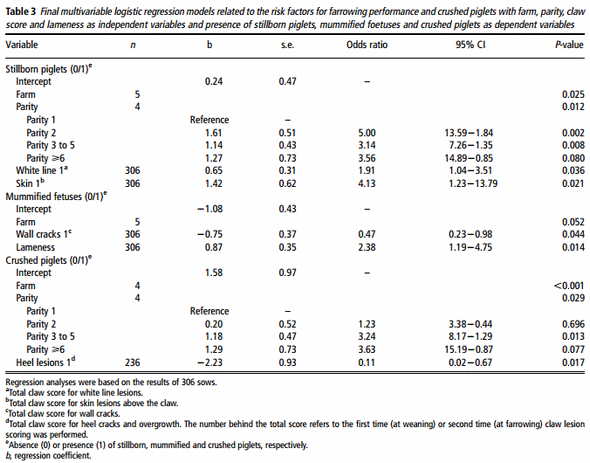
Figure 3 shows the percentage of sows that were scored lame at the three visual lameness assessments (L1-L2-L3). The mean percentage of lame sows for all farms was 5.5 6 3.3%, 8.1 6 6.1% and 4.1 6 4.4% at L1, L2 and L3, respectively. The difference between L1, L2 and L3 was found to be significant (P 5 0.027) and the prevalence of lameness significantly varied according to the farm (P 5 0.002). The interaction between farm and measuring period was not significant. On every farm, the percentage of lame sows peaked at the moment of the second lameness investigation, that is, when sows were moved from the insemination stable to the gestation stable. At L1, 27 sows were assessed to be lame. Of these, nine sows left the group before L2 could be performed. At L2, a total of 32 lame sows were found. Only two sows that were lame at L1 were still lame at L2 and four sows that were lame at L2 were also lame at L3. There was no significant difference in parity between sows that were lame (mean parity of 2.6 6 1.7) and sows that were not lame (mean parity of 2.5 6 1.7).
Discussion Direct impact On the basis of the models, some claw lesions seem to have a direct impact on farrowing performance of sows. An effect of claw lesions on reproductive performance was also reported by De Pita (2010), Anil (2011) and Fitzgerald et al. (2012) but could not be shown by Enokida et al. (2011). In the present study, white line lesions and skin lesions above the claw increased the risk for stillborn piglets. Both skin lesions and white line lesions may facilitate entry of bacteria causing infection, pain and clinical lameness. An association between white line lesions and lameness in breeding sows was described by Anil et al. (2007). De Pita (2010) reported a positive association between white line lesions and the likelihood of having <10 piglets born alive. In the same study, the likelihood of having <10 piglets born alive was positively associated with the number of stillborn piglets. The reason why sows with wall cracks have lower odds of having mummified foetuses remains unknown.
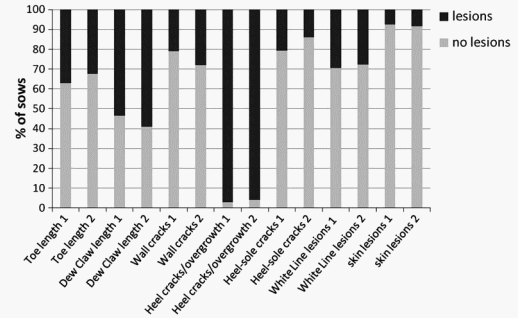
Figure 2 Percentage of sows (total of 381) with and without lesions for each of the seven claw parameters that were scored at the first (1) and second (2) time claw lesion scoring was carried out. 1, performed at the end of the first lactation period, at the beginning of the study; 2, performed 5 days after parturition in the second lactation period, at the end of the study
Contrary to claw lesions, a clear direct impact of lameness on breeding and farrowing performance could not be shown with the exception of the effect on mummified foetuses. Lameness is a clinical sign that shows that movement is painful. The higher serum concentrations of acute-phase proteins in lame sows reported by Heinonen et al. (2006) indicate the presence of inflammatory processes. Pain and inflammation may cause reduction in feed intake and consequently may lead to a poor body condition of the sow.
Poor body condition has been associated with the presence of mummified foetuses in sows (Knauer et al., 2006).
Apart from the effect on mummified foetuses, no effect of lameness on reproduction was found in the present study. This is in contrast with the lower number of piglets born alive and higher piglet losses before weaning reported by Grandjot (2007) and Anil et al. (2009). The absence of a significant association between lameness and reproductive performance may be explained by the fact that reproduction results may strongly differ between individual sows. Therefore, it can be suggested to evaluate the impact on reproduction in longitudinal studies covering several reproductive cycles and using a sow as her own reference. However, in this study, parity and farm, as indicators for breed effect, were already taken into account when performing linear and logistic regression.
Indirect impact
In addition to the direct impact, lameness and claw lesions are assumed to have an indirect impact on reproduction results. Indeed, a relationship with the risk of removal from the farm was found as well as a significant association between heel lesions and crushed piglets.
With a prevalence of 15%, feet- and leg problems appeared to be the second most important reason for sow removal in this study. Moreover, sows removed from the farm because of feet and leg problems were significantly younger compared with sows removed because of other reasons. The finding that feet and leg problems are important reasons of early culling is in agreement with the results of other studies (Stalder et al., 2003; Engblom et al., 2007; Jensen et al., 2010). Sows reach peak production between the third and sixth parity. Hence, removal of sows at a mean parity of 2.6 implies that part of the sows did not reach their most productive parities, nor repaid their investment costs yet (Ritter et al., 1999; Stalder et al., 2003; Anil et al., 2009). A higher removal rate also increases replacement costs and the frequency of adding new gilts, which in turn implicates a higher health risk to the animals currently in the farm.
In this study, a negative association was found between the presence of heel lesions and presence of crushed piglets. Heel lesions are very common among sows. The high percentage of sows with heel lesions (96%) in this study is in agreement with the results of previous studies (Gjein and Larssen, 1995; Anil et al., 2007; Pluym et al., 2011). Only a few sows did not have any heel lesion. Owing to the low number of sows without lesions, the association found between heel lesions and crushed piglets may not be an effect but just coincidence.
Prevalence of claw lesions and lameness
To be able to perform thorough risk factor analysis, and to start prevention at the right moment, knowledge on the changes in the prevalence of lameness and claw lesions throughout the reproductive cycle is important. The mean global score in general remained unchanged but significantly improved from first to second claw lesion scoring on farms 1 and 4. Trimming of long toes and healing of lesions may have contributed to this improvement. The high prevalence of sows with heel cracks and overgrowth was also observed in other studies (Gjein and Larssen, 1995; Anil et al., 2007; Pluym et al., 2011). The mean prevalence of lameness namely 5.6%, 8.7% and 5.1% at L1, L2 and L3, respectively, were slightly lower compared with the prevalence of 9.7% that was found in an earlier study conducted on Belgian farms (Pluym et al., 2011). High differences between farms, as seen in other studies (Heinonen et al., 2006; Pluym et al., 2011), were also noticed in this study. Group housing is mentioned as an important risk factor for lameness (Anil et al., 2005; Chapinal et al., 2010). Notwithstanding, in this study, the prevalence of lameness was lowest at the end of the gestation period (L3) and highest at the moment the sows were moved from the insemination stable to the gestation stable (L2). On farm 2, lameness assessment could not be done when sows were moved from the insemination to the gestation stable, and therefore had to be done 2 weeks after the sows were introduced in group housing (stable groups). However, even without this farm, the prevalence remained highest at L2 (data not shown). Group housing probably can influence the development of lameness, especially shortly after introduction when sows fight to establish a dominance hierarchy. When this equilibrium is found, sows may have the time to heal from their injuries (Arey, 1998). Nevertheless, results of this study suggest that even housing in the insemination stable may have an impact on the development of lameness. The increase in prevalence at L2 is caused by a higher number of lame sows and not by a lower number of total sows owing to the sows leaving the group between L1 and L2. In the insemination stable, sows were housed in conventional stalls. Owing to immobility, muscle conformation and bone strength can deteriorate (Marchant and Broom, 1994). However, in the present study, sows were housed in stalls for at most 5 weeks, whereas impact of restricted mobility on the development of muscle and bone strength (Marchant and Broom, 1994), as well as on lameness (Karlen et al., 2007), could only be shown after housing sows in stalls during almost the entire gestation period.
In addition to the differences between L1, L2 and L3, the prevalence of lameness significantly varied between farms. Differences in management (e.g. handling of animals, moving the sows at the time of oestrus detection) might explain the variation between farms. These results indicate that the prevalence of lameness differs throughout the reproductive cycle and that changes vary according to the farm. This substantiates our suggestion that lameness should be assessed several times during the reproductive cycle.
Conclusion
A direct effect of certain claw lesions on the farrowing performance of sows was shown, whereas for lameness a clear indirect impact on (re)production results was found. The prevalence of lameness differed between farms and varied throughout the reproductive cycle. Housing in the insemination stable seems to induce more lameness than housing in the gestation stable in the farms studied. Therefore, further investigation on risk factors, especially related to the insemination stable and introduction of sows in group housing is needed.
Acknowledgements
This research was granted by ‘The Institute for Innovation through Science and Technology (IWT) Flanders, Belgium’ (Innovation study SB-091420). The authors are grateful to the farmers for their willingness to cooperate in this study.
References
Andersen IL and Bøe KE 1999. Straw bedding or concrete floor for loose-housed pregnant sows: consequences for aggression, production and physical health. Acta Agriculturae Scandinavica, Section A – Animal Science 49, 190–195.
Anil SS 2011. Epidemiology of lameness in breeding female pigs. PhD University of Minnesota. Anil SS,
Anil L and Deen J 2009. Effect of lameness on sow longevity. Journal of the American Veterinary Medical Association 235, 734–738.
Anil L, Anil SS, Deen J, Baidoo SK and Wheaton JE 2005. Evaluation of well-being, productivity and longevity of pregnant sows housed in groups in pens with an electronic sow feeder or separately in gestation stalls. American Journal of Veterinary Research 66, 1630–1638.
Anil SS, Anil L, Deen J, Baidoo SK and Walker RD 2007. Factors associated with claw lesions in gestating sows. Journal of Swine Health and Production 15, 78–83.
Arey DS 1998. Time course for the formation and disruption of social organization in group-housed sows. Applied Animal Behaviour Science 62, 199–207.
Bonde M, Rousing T, Badsberg JH and Sørensen JT 2004. Associations between lying-down behaviour problems and body condition, limb disorders and skin lesions of lactating sows housed in farrowing crates in commercial sow farms. Livestock Production Science 87, 179–187.
Chapinal N, Ruiz de la Torre JL, Cerisuelo A, Gasa J, Baucells MD, Coma J, Vidal A and Manteca X 2010. Evaluation of welfare and productivity in pregnant sows kept in stalls or in 2 different group housing systems. Journal of Veterinary Behavior 5, 82–93.
Deen J, Anil SS, Anil L and Baidoo S. 2008. Lameness overview and awareness: implications for welfare, housing, performance and economics. FeetFirstTM Symposium on Sow Lameness, Asten/Sterksel, The Netherlands, 4pp.
De Pita ADS. 2010. Sow lameness and claw lesions evaluation. Master Thesis, University of Minnesota. Engblom L, Lundeheim N, Dalin AM and Andersson K 2007. Sow removal in Swedish commercial farms. Livestock Science 106, 76–86.
Enokida M, Sasaki Y, Hoshino Y, Saito H and Koketsu Y 2011. Claw lesions in lactating sows on commercial farms were associated with postural behavior but not with suboptimal reproductive performance or culling risk. Livestock Science 136, 256–261.
Feet FirstR Team 2010. Feet FirstR swine claw lesion identification. Retrieved December 23, 2010, from http://www.zinpro.com/lameness/swine/ lesion-identification.
Fitzgerald RF, Stalder KJ, Karriker LA, Sadler LJ, Hill HT, Kaisand J and Johnson AK 2012. The effect of hoof abnormalities on sow behavior and performance. Livestock Science 145, 230–238.
Gjein H and Larssen RB 1995. Housing of pregnant sows in loose and confined systems – a field study. 2. Claw lesions: morphology, prevalence, location and relation to age. Acta Veterinaria Scandinavica 36, 433–442.
Grandjot G 2007. Claw problems cost money SUS-Schweinezucht und Schweinemast Landwirtschaftsverlag GmbH. Munster-Hiltrup, Germany 5, 28–31.
Heinonen M, Oravainen J, Orro T, Seppa¨-Lassila L, Ala-Kurikka E, Virolainen J, Tast A and Peltoniemi OAT 2006. Lameness and fertility of sows and gilts in randomly selected loose-housed farms in Finland. The Veterinary Record 159, 383–387.
Hoofs AIJ, Netwerk ‘perfecte zeugenklauw’ 2006. De Nederlandse Zeugenklauwencheck (in Dutch). Retrieved December 23, 2010, from http:// www.verantwoordeveehouderij.nl/netwerken/enquete/zeugenklauwencheck/ Klauwencheck.pdf.
Jensen TB, Bonde MK, Kongsted AG, Toft N and Sørensen JT 2010. The interrelationships between clinical signs and their effect on involuntary culling among pregnant sows in group-housing systems. Animal 4, 1922–1928.
Johnson RW 1997. Inhibition of growth by pro-inflammatory cytokines: an integrated view. Journal of Animal Science 75, 1244–1255.
Karlen GAM, Hemsworth PH, Gonyou HW, Fabrega E, Strom AD and Smits RJ 2007. The welfare of gestating sows in conventional stalls and large groups on deep litter. Applied Animal Behaviour Science 105, 87–101.
Knauer MT, Stalder KJ, Karriker L, Johnson C and Layman L. 2006. Factors influencing sow culling. Retrieved November 2, 2012, from http://www.nsif. com/Conferences/2006/pdf/FactorsInfluencingSowCulling.pdf. Kroneman A, Vellenga L, van der Wilt FJ and Vermeer HM 1993. Field research on veterinary problems in group-housed sows – a survey of lameness. Journal of Veterinary Medicine A 40, 704–712.
Marchant JN and Broom DM 1994. Effects of housing system on movement and leg strength in sows. Applied Animal Behaviour Science 41, 275–276.
Mouttotou N, Hatchell FM and Green LE 1999. Foot lesions in finishing pigs and their associations with the type of floor. The Veterinary Record 144, 629–632.
Newton GL, Booram CV, Hale OM and Mullinix G Jr 1980. Effects of four types of floor slats on certain feet characteristics and performance of swine. Journal of Animal Science 50, 7–20.
Pluym L, Van Nuffel A, Dewulf J, Cools A, Vangroenweghe F, Van Hoorebeke S and Maes D 2011. Prevalence and risk factors of claw lesions and lameness in pregnant sows in two types of group housing. Veterinarni Medicina 56, 101–109.
Ritter LA, Xue J, Dial GD, Morrison RB and Marsh WE 1999. Prevalence of lesions and body condition scores among female swine at slaughter. Journal of the American Veterinary Medical Association 214, 525–528.
Rowles C 2001. Sow lameness. Journal of Swine Health and Production 9, 130–131.
Simmins PH and Brooks PH 1988. Supplementary biotin for sows: effect on claw integrity. Veterinary Record 122, 431–435.
Schuttert M, 2008. The economical impact of lameness in sows. FeetFirstTM Symposium on Sow Lameness, Asten/Sterksel, The Netherlands, 4pp.
Stalder KJ, Lacy CR, Cross TL and Conatser GE 2003. Financial impact of average parity of culled females in a breed-to-wean swine operation using replacement gilt net present value analysis. Journal of Swine Health and Production 11, 69–74.
Welfare QualityR 2009. Welfare QualityR assessment protocol for pigs (sows and piglets, growing and finishing pigs).
Welfare QualityR Consortium, Lelystad, The Netherlands. Whay HR, Main DCJ, Green LE and Webster AJF 2003. Animal-based measures for the assessment of welfare state of dairy cattle, pigs and laying hens: consensus of expert opinion. Animal Welfare 12, 205–217.
Willgert K, 2011. The economic and welfare impact of lameness in sows in England. Retrieved January 10, 2012, from http://www.fao.org/fileadmin/ user_upload/animalwelfare/Theeconomicandwelfareimpactoflamenessinsowsin England.pdf. Eco

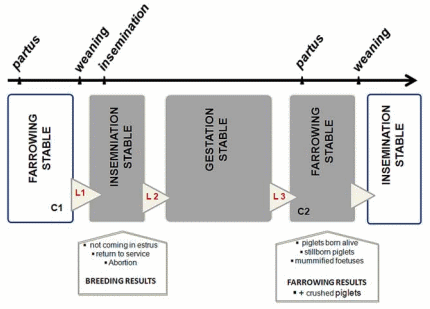



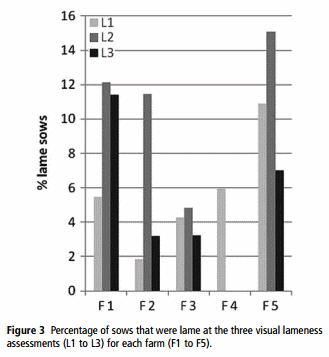








.jpg&w=3840&q=75)